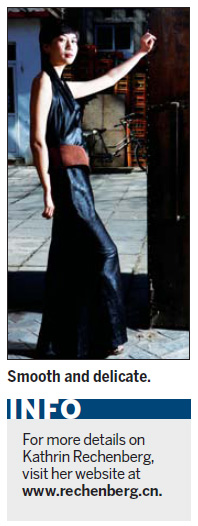
|
German designer Kathrin Rechenberg. [Photo/China Daily] |
"I'm passionate about tea-silk," said Kathrin Rechenberg in her bright and airy studio just north of the Sanlitun embassy district.
Taiwan fashion designer Sophie Hong introduced the Munich-born Rechenberg to tea-silk, and this fabric, along with her Chinese husband, who hails from Wuhan, was what brought her to China in 2000.
"I buy silk from all over China," Rechenberg said, "but there is only one place, in Guangdong (province), that prepares the fabric in the traditional tea-silk way."
This method involves dying the silk up to 40 times in tea and other organic ingredients and, after each dying, spreading it out on the grass to dry in the sun. During the process, the silk is covered with mud, giving it a unique papyrus texture.
Along with Hong and Donna Karan, Rechenberg is one of the few designers using tea-silk.

"Designers know about it, but it's very hard to work with, so you don't make lots of money on it," she said.
Rechenberg's love of tea-silk stems not only from her long-standing interest in Chinese hand-woven clothing, but also from her training at the Ecole de la Chambre Syndical de la Coutre in Paris and subsequent work in haute couture houses like Christian Dior and Christian Lacroix.
When asked about how those fashion houses shaped her work, she replied: "The most important things I learned from them are the techniques of haute couture and the joy of working with the finest materials."
In addition to its smooth and delicate texture, tea-silk has a unique sheen that becomes more glossy and colorful with age.
Rechenberg showed off three items from her latest collection. One is a long black "bias cut" dress. This cut, pioneered by the legendary French designer Madeleine Vionnet, accentuates a woman's natural shape and is in line with Rechenberg's belief that "clothes shouldn't hide the character of the woman wearing them".
Another item is a double tea-silk chiffon jacket that can be worn inside out and upside down, thus functioning as several different outfits in one. When worn inside out, it features exquisitely stitched rust-colored seams.
Lastly, there is a tea-silk padded silk wrapped top, which was inspired "by lengths of tea-silk fabric strips laid out to dry on the grass". This dark cinnamon colored outfit can also be worn several different ways.
Rechenberg said she is "greatly inspired by wrapped layers of clothes worn during the Tang Dynasty (AD 618-907)".
Most of her outfits are in dark and solid colors, as the "tea-silk lends itself to darker colors". They have a simple and cool elegance, and on close inspection, one can notice subtle patterns, like the barely visible characters on the tea-silk chiffon.
The combination of understated German chic and tea-silk has won Rechenberg a large local clientele. "Half my customers are Chinese," she said, adding that unlike their Shanghai counterparts, Beijing women are "more influenced by art" when selecting clothes they want to wear.